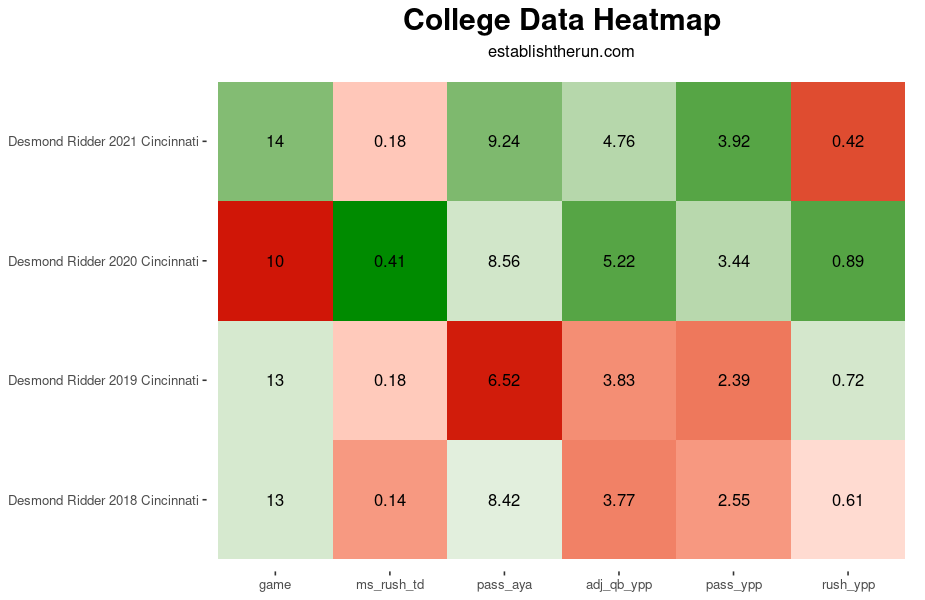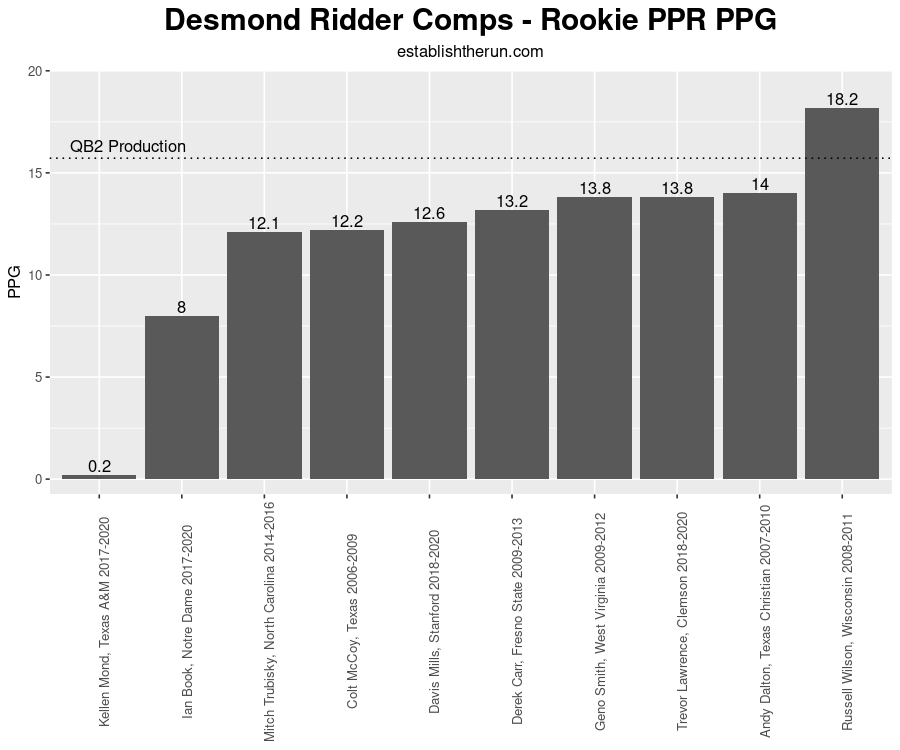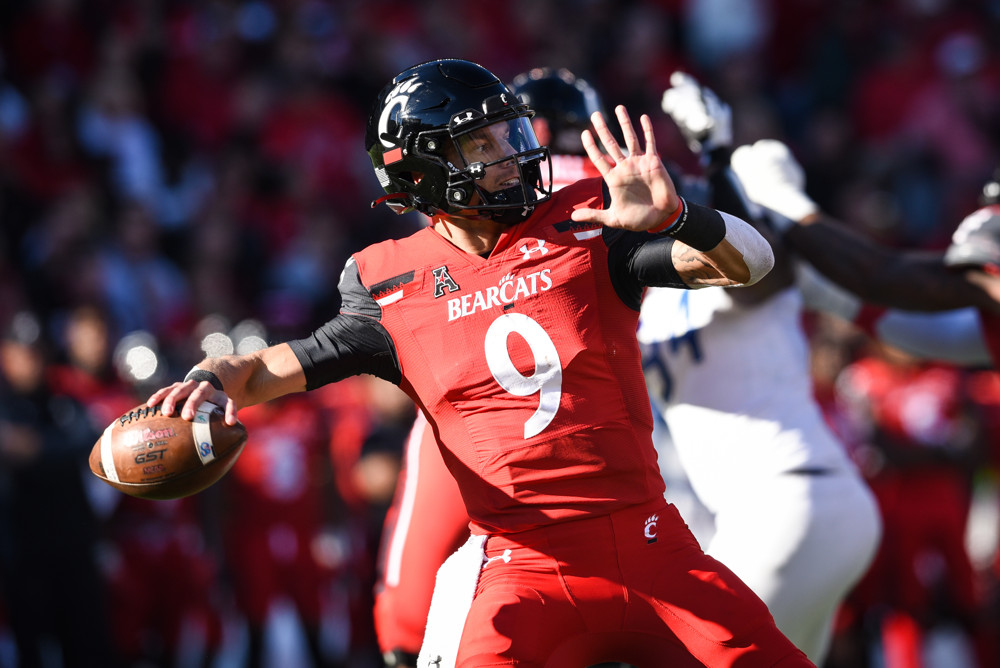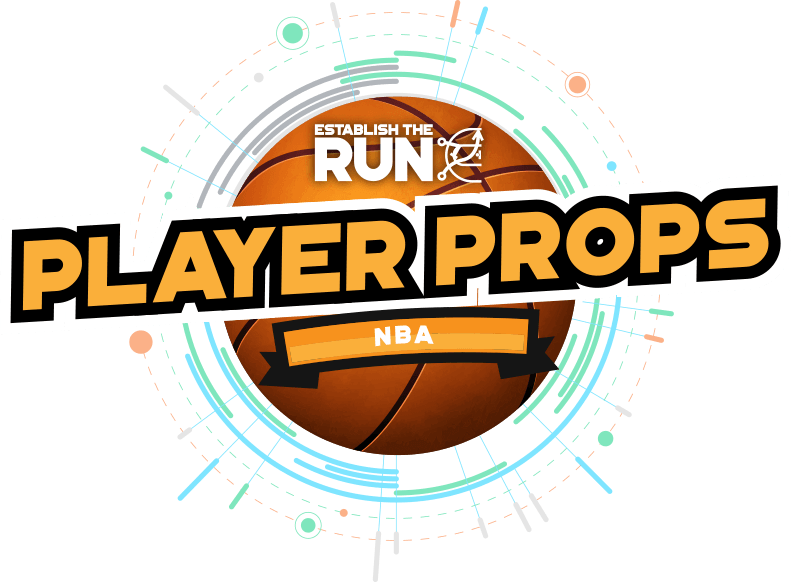Dynasty Outlook
March 25
Desmond Ridder is currently in our third tier of QBs for rookie drafts, and is outside of the top 24 QBs in our overall dynasty ranks. His high floor and athleticism make Ridder a target on the Round 1/2 fringe in Superflex rookie drafts, but he is not a priority at the position in single-QB formats. For him to reach his ceiling, fantasy gamers will need Ridder to tap into his 4.52 tested speed in the 40. The scouts do not seem to think that is his play style. We should expect Ridder to get a season’s worth of starts at some point, with a decent chance to be a long-term starter compared to other players at the position.
Profile Summary
As a four-year starter who upped the level of the entire Cincinnati program, Ridder has a high floor both in terms of his draft capital and on-field results. He is extremely athletic, but as the scouts note, he is more of an athletic pocket passer than a QB we will see running with high frequency. Ridder is expected to be a top-50 pick, and has been getting some first-round buzz as the process has gone on. He has never been a statistically dominant QB.
Vitals
Age (as of 12/31/21) — 22.4
Experience — 5 years
Height — 75.375 inches
Weight — 211 pounds
Hand Size — 10 inches
Arm Length — 32.75 inches
Wingspan — 79 inches
Forty — 4.52
Vertical — 36 inches
Broad — 127 inches
By the Numbers

Ridder redshirted his first year on campus, but then proceeded to start for Cincinnati the next four years. His last two seasons were his best, with his redshirt junior year being the most productive as a rusher (592 yards, 12 TDs). Ridder was at his best as a passer in his final year, and it culminated in the Bearcats making a trip to the College Football Playoff — the first in school history.
In very public fashion, Ridder struggled against Alabama in the playoff, but has mostly been good against top teams. Over his last two seasons, Ridder faced top-50 defenses nine times, completing 62% of his passes with 14 TDs and two INTs. His 154 pass efficiency rating is about on par with his performance overall — solid, but not spectacular.
It was a little surprising to not see more rushing production on Ridder’s résumé. He clearly showed in 2020 that he could do it — and ran a 4.52 at the NFL Combine — but didn’t take off as much in 2021. This could indicate that his play style doesn’t really match the athleticism.
What the Scouts are Saying
Daniel Jeremiah has had minimal commentary on Ridder, but mentioned him in his annual conference call with league media:
And when you look at Ritter (Ridder), how high he can go, look, I like him. He’s got that kind of whippy motion. He’s got a real live arm. He’s a smooth athlete. I just thought the accuracy was the concern, just consistently placing the ball where it needs to be. That to me was the problem. His base gets a little bit wide at times and the ball takes off on him and sails. To me, I think he’s a second-round range I think is where you see him come off the board. If he aces it, if he aces this process going forward, meeting with these teams and workouts and shows you that he’s improved some of those things, everything I’ve been told as an off-the-field character, intelligence, leadership, outstanding. Maybe he’s got a chance to sneak his way into the bottom of Round 1, but I would say at this point in time, where I have him, where most people have him that I talk to around the league, he’s kind of viewed as a second-round pick.
Dane Brugler also noted an issue with Ridder’s release:
A tall, lean passer, Ridder moves with light feet and is comfortable making throws on the move. His release gets a tad long and his accuracy needs to be more consistent, but Ridder has enjoyed a lot of success on the football field because of his confidence and willingness to use the entire field. He will compete for starting reps early in his career.
Lance Zierlein noticed the divergence between Ridder’s athleticism and play style that we found in the numbers:
Four-year starter and four-year winner whose hard work at his craft altered his standing from good college quarterback to early-round draft pick. There is nothing special about Ridder’s size or arm talent, but his improved confidence and field command have really helped him mature at the position. He plays in rhythm and operates with consistently repeatable footwork and mechanics. He’s intelligent and processes quickly, which should help him find where the football needs to go regardless of passing scheme. Getting the ball to NFL targets accurately and safely, however, is not a given. Despite favorable mechanics, his accuracy and ball placement need work and he doesn’t have the arm strength or release quickness to consistently survive off-target throws against pro coverage. He can run but is more of a pocket passer who can win with his legs than a true dual-threat quarterback.
Draft Projection
Ridder currently has an expected draft position of 35.1 on Grinding the Mocks, which sources mock drafts around the interwebs. NFL Mock Draft Database, a similar service, has him 38th overall. He goes 32nd in Brugler’s most recent mock. Ridder seems likely to come off the board at the end of Round 1 or start of Round 2.
Comparable Players
I use Principal Component Analysis to evaluate QB prospects. In simplest terms, this kind of analysis looks at relevant data points to find the closest comparable QBs in past drafts. I prefer this to a model output — which yields only a single result — as it can display the possible range of outcomes for a prospect.
Note that the analysis itself isn’t telling us how good a player is; it is simply returning the most similar players. It is then up to us to layer in context and past results to see how good we think this player may be.
QB comps are noticeably difficult to come up with given the overall sample size of players we have to observe. We should be using the comps to see A) What is the likelihood this QB is a long-term starter and B) If he is, what is his upside?

While other passers we’ve studied may have a higher ceiling, Ridder certainly has the highest floor. Eight of his comps have or will start at least a season’s worth of games, and the other two were 2021 draft picks that we have not seen (much of) yet. This is probably going to have more value for dynasty players in Superflex formats — where starts come at a premium — versus single-QB formats that prioritize more upside.
The Russell Wilson comp provides a good look at Ridder’s ceiling, but is a low-probability outcome. A pocket passer with mobility seems most likely, especially when parsing in what the scouts say. Only one of his comps was not selected on the first two days of the draft.



